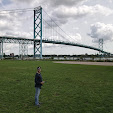Welcome to the gateway page for Gribblenation’s series on the bridges of the lower Mississippi River in Memphis, TN! Here you will find links to information about the four bridges that span the river at Memphis. The bridges of Memphis were constructed during the period between the height of the railroad era in the 1890s and the height of the modern interstate highway era of the 1970s. Each has a unique story to tell and all play a vital part in the transportation system of the northern Mississippi Delta.

From left to right, the Harahan Bridge (1916), Frisco Bridge (1892), and Memphis & Arkansas Bridge (1949) combine to create one of the most impressive bridge-related visuals on the Mississippi River.
Harahan Bridge/"Big River Crossing"
The Harahan Bridge was built immediately upriver in 1916 and is also a railroad bridge. Built to supplement the Frisco Bridge as a railroad crossing, it was also the first bridge at Memphis to feature roadways (or “wagonways”) for automobile traffic. The former roadway on the north side of the structure was revitalized and opened as a pedestrian and bicycle trail in 2016 as the “Big River Crossing”.

Harahan Bridge/"Big River Crossing"(1916/2016)
Memphis & Arkansas Bridge
The Memphis & Arkansas Bridge was built immediately downriver in 1949 and was the first bridge at Memphis to be purpose-built for vehicle traffic. The bridge is part of Interstate 55 and a slew of US Highways. These first three bridges are located within a few hundred feet of one another and are an impressive sight to take in – one of the most spectacular bridge-related sights on the Mississippi River.
The Harahan Bridge was built immediately upriver in 1916 and is also a railroad bridge. Built to supplement the Frisco Bridge as a railroad crossing, it was also the first bridge at Memphis to feature roadways (or “wagonways”) for automobile traffic. The former roadway on the north side of the structure was revitalized and opened as a pedestrian and bicycle trail in 2016 as the “Big River Crossing”.

Harahan Bridge/"Big River Crossing"(1916/2016)
Memphis & Arkansas Bridge
The Memphis & Arkansas Bridge was built immediately downriver in 1949 and was the first bridge at Memphis to be purpose-built for vehicle traffic. The bridge is part of Interstate 55 and a slew of US Highways. These first three bridges are located within a few hundred feet of one another and are an impressive sight to take in – one of the most spectacular bridge-related sights on the Mississippi River.
Hernando de Soto Bridge
The Hernando de Soto Bridge was built in 1973 across from downtown Memphis and serves as an additional vehicle crossing of the river that supplements the Memphis & Arkansas Bridge a short distance downriver. The signature M-shaped bridge is part of Interstate 40 and gained national attention in 2021 for a failed inspection that resulted in a full closure of the bridge for a period.
The Hernando de Soto Bridge was built in 1973 across from downtown Memphis and serves as an additional vehicle crossing of the river that supplements the Memphis & Arkansas Bridge a short distance downriver. The signature M-shaped bridge is part of Interstate 40 and gained national attention in 2021 for a failed inspection that resulted in a full closure of the bridge for a period.
How To Get There:
Bridges, Crossings, and Structures of the Lower Mississippi River
Return to the Bridges of the Lower Mississippi River Home Page
__________________________________________________
Bridges, Crossings, and Structures of the Lower Mississippi River
Return to the Bridges of the Lower Mississippi River Home Page
__________________________________________________





Comments